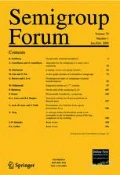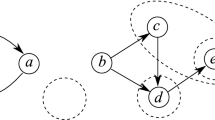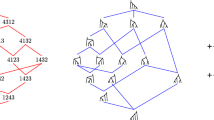Abstract
We present a framework for the composition of overlapping objects based on semigroup theory. To do so, we develop a language theory of (labelled) birooted trees, that is, subsets of (extension of) free inverse monoids. In the underlying setting of partial algebras, we define a suitable notion of a syntactic congruence such that (i) having a syntactic congruence of finite index captures \(\mathrm{MSO}\)-definability; (ii) a certain order-bisimulation refinement of the syntactic congruence captures (so called) quasi-recognisability in the same way.


Similar content being viewed by others
Notes
Otherwise, there is no need of a zero.
Equivalently for all since the relation \(\simeq \) is closed.
The left (or right) projection of a quasi-recognisable language may not be quasi-recognisable.
Or, by (M6), for all.
References
Berthaut, F., Janin, D., Martin, B.: Advanced synchronization of audio or symbolic musical patterns: an algebraic approach. Int. J. Semant. Comput. 6(4), 409–427 (2012)
Bojańczyk, M., Walukiewicz, I.: Forest algebras. In: Logic and Automata, pp. 107–132. Amsterdam University Press (2008)
Burmeister, P.: A Model Theoretic Oriented Approach to Partial Algebras. Akademie, Berlin (1986)
Cornock, C., Gould, V.: Proper two-sided restriction semigroups and partial actions. J. Pure Appl. Algebra 216, 935–949 (2012)
Courcelle, B., Weil, P.: The recognizability of sets of graphs is a robust property. Theor. Comput. Sci. 342, 173–228 (2005)
Danos, V., Regnier, L.: Reversible, irreversible and optimal lambda-machines. Theor. Comput. Sci. 227(1–2), 79–97 (1999)
Dicky, A., Janin, D.: Modélisation algébrique du diner des philosophes. In Modélisation des Systèmes Réactifs (MSR), in Journal Européen des Systèmes Automatisés (JESA Volume 47 - no 1-2-3/2013) (2013)
Ésik, Z., Weil, P.: On logically defined recognizable tree languages. In Found. of Soft. tech and Theor. Comp. Science (FSTTCS), pp. 195–207 (2003)
Gould, V., Hollings, C.: Actions and partial actions of inductive constellations. Semigr. Forum 82(1), 35–60 (2011)
Hollings, C.D.: From right PP monoids to restriction semigroups: a survey. Eur. J. Pure Appl. Math. 2(1), 21–57 (2009)
Janin, D.: Vers une modélisation combinatoire des structures rythmiques simples de la musique. Revue Francophone d’Informatique Musicale (RFIM), 2 (2012)
Janin, D.: Algebras, automata and logic for languages of labeled birooted trees. In: Int. Col. on Aut., Lang. and Programming (ICALP), volume 7966 of LNCS, pp. 318–329. Springer, Berlin (2013)
Janin, D.: On languages of one-dimensional overlapping tiles. In Int. Conf. on Current Trends in Theo. and Prac. of Comp. Science (SOFSEM), volume 7741 of LNCS, pp. 244–256. Springer, Berlin (2013)
Janin, D.: Overlaping tile automata. In: 8th International Computer Science Symposium in Russia (CSR), volume 7913 of LNCS, pp. 431–443. Springer, Berlin (2013)
Janin, D.: Walking automata in the free inverse monoid. Research report RR-1464-12, LaBRI, Université de Bordeaux (2013)
Janin, D.: Towards a higher dimensional string theory for the modeling of computerized systems (invited talk). In: Int. Conf. on Current Trends in Theo. and Prac. of Comp. Science (SOFSEM), volume 8327 of LNCS, pp. 7–20. Springer, Berlin (2014)
Janin, D., Berthaut, F., DeSainteCatherine, M.: Multi-scale design of interactive music systems: the libTuiles experiment. In: Sound and Music Computing (SMC) (2013)
Jongh, D., Troelstra, A.: On the connection of partially ordered sets with some pseudo-boolean algebras. Indag. Math. 28, 317–329 (1966)
Kellendonk, J.: The local structure of tilings and their integer group of coinvariants. Commun. Math. Phys. 187, 115–157 (1997)
Kellendonk, J., Lawson, M.V.: Tiling semigroups. J. Algebra 224(1), 140–150 (2000)
Körtesi, P., Radeleczki, S., Szilágyi, S.: Congruences and isotone maps on partially ordered sets. Math. Pannon. 16(1), 39–55 (2005)
Lawson, M.V.: Inverse Semigroups: The Theory of Partial Symmetries. World Scientific, Singapore (1998)
Lawson, M.V.: McAlister semigroups. J. Algebra 202(1), 276–294 (1998)
Margolis, S.W., Pin, J.-E.: Languages and inverse semigroups. In: Int. Col. on Aut., Lang. and Programming (ICALP), volume 172 of LNCS, pp. 337–346. Springer, Berlin (1984)
McAlister, D.B.: Inverse semigroups which are separated over a subsemigroups. Trans. Am. Math. Soc. 182, 85–117 (1973)
Shelah, S.: The monadic theory of order. Ann. Math. 102, 379–419 (1975)
Silva, P.V.: On free inverse monoid languages. ITA 30(4), 349–378 (1996)
Stephen, J.B.: Presentations of inverse monoids. J. Pure Appl. Algebra 63, 81–112 (1990)
Thomas, W.: Chap. 7. Languages, automata, and logic. In: Handbook of Formal Languages, vol. III, pp. 389–455. Springer, Berlin (1997)
Thomas, W.: Ehrenfeucht games, the composition method, and the monadic theory of ordinal words. In: Structures in Logic and Computer Science, volume 1261 of LNCS, pp. 118–143. Springer, Berlin (1997)
Author information
Authors and Affiliations
Corresponding author
Additional information
Communicated by Mark V. Lawson.
Rights and permissions
About this article
Cite this article
Blumensath, A., Janin, D. A syntactic congruence for languages of birooted trees. Semigroup Forum 91, 675–698 (2015). https://doi.org/10.1007/s00233-014-9677-x
Received:
Accepted:
Published:
Issue Date:
DOI: https://doi.org/10.1007/s00233-014-9677-x




